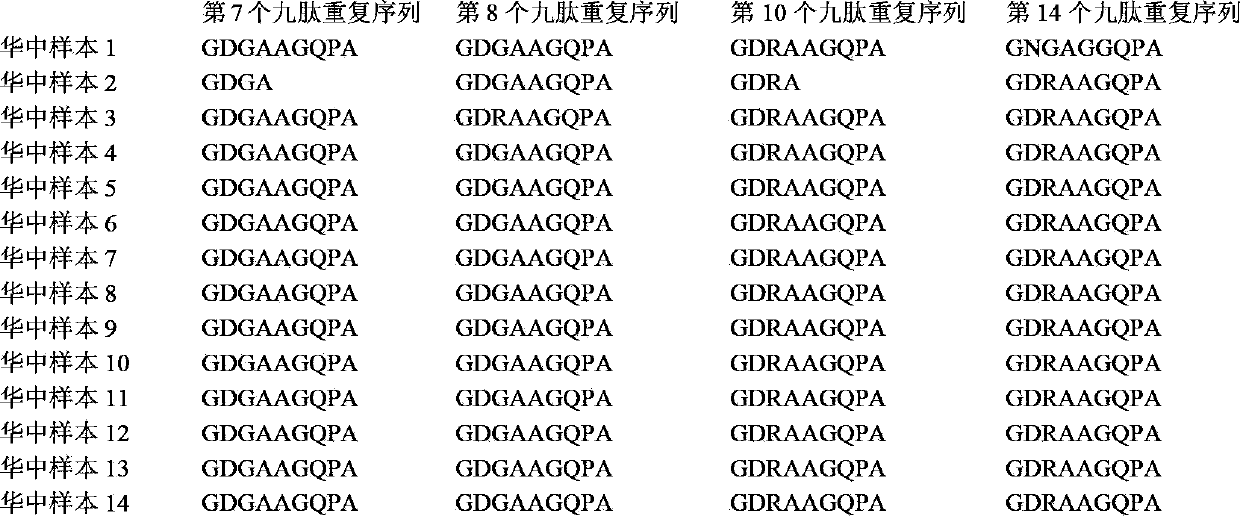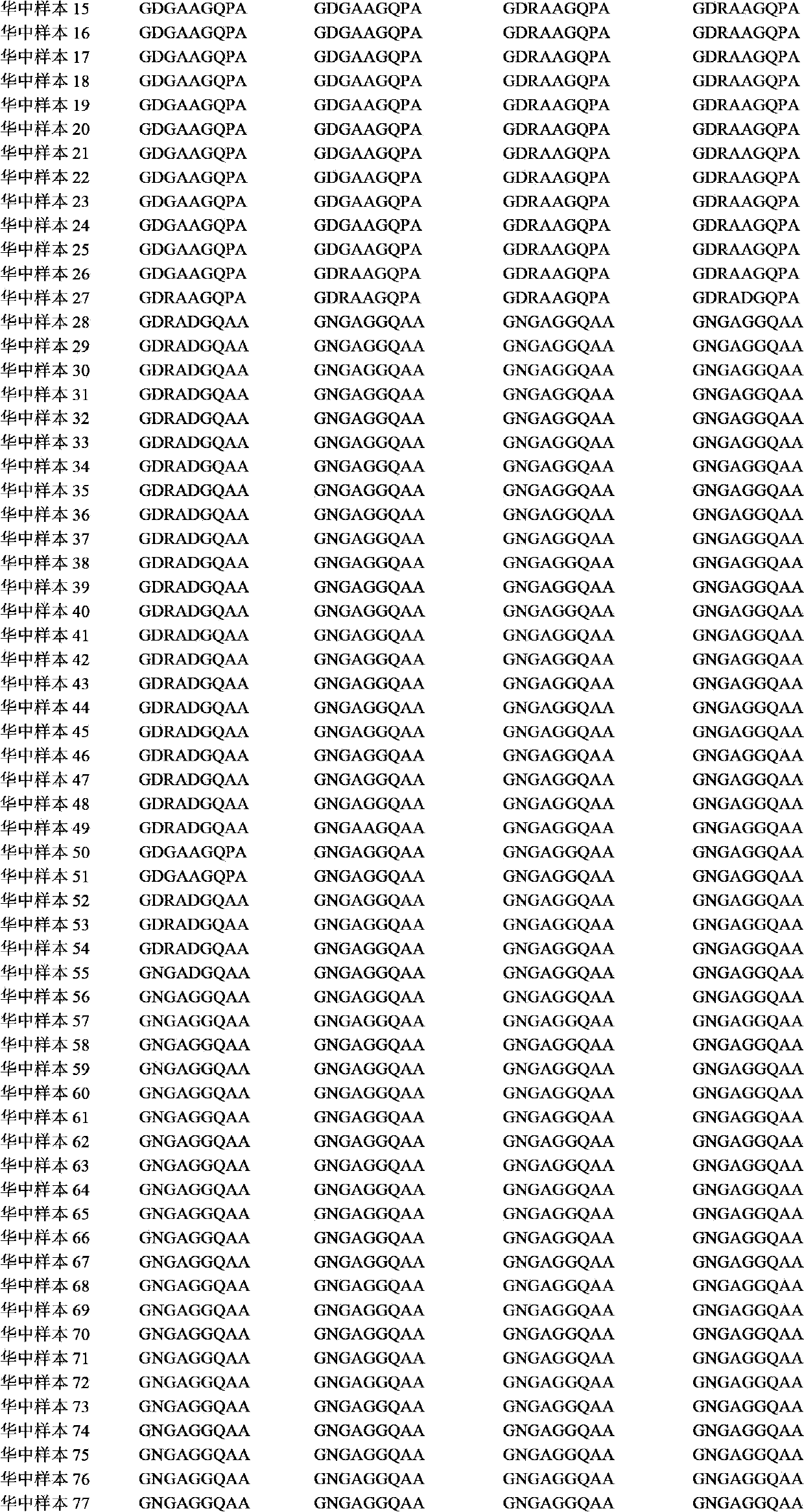Geographically-specific Plasmodium vivax molecule marker, and its application in strain tracing
A molecular marker, Plasmodium technology, applied in the field of biotechnology and molecular biology, can solve the problem of difficult to fully reflect the genetic characteristics of the strain population
- Summary
- Abstract
- Description
- Claims
- Application Information
AI Technical Summary
Problems solved by technology
Method used
Image
Examples
Embodiment 1
[0139] Classification of core nonapeptide repeats in the central repeat region of the circumsporozoite protein of Plasmodium vivax, and creation of a characterization model
[0140] 1. Detection of the core nonapeptide repeat sequence in the central repeat region of the circumsporozoite protein of Plasmodium vivax
[0141] (a) Design of primers
[0142] The sequence is from the reference sequence of Plasmodium vivax Belem strain (see SEQ ID NO: 1 for the full sequence, GenBank accession no. M 11926).
[0143] The outer primers for amplifying the central repeat region are:
[0144] CSP-WF: 5'GCATAAGGCAAACTCACAAA 3' (SEQ ID NO: 4),
[0145] CSP-WR: 5'CGCATAATGTGTAAGAGGTGT 3' (SEQ ID NO: 5).
[0146] The inner primer is: T-CS-F:5'AAGCAAGCAAAACAGCCAAA 3'(SEQ ID NO:6),
[0147] T-CS-R: 5'GCAAACAGCAGGGAACATT 3' (SEQ ID NO: 7).
[0148] (b) PCR amplification conditions are: 98° C. for 20 seconds (denaturation), 57° C. for 30 seconds (annealing) and 68° C. for 60 seconds (extensi...
Embodiment 2
[0183] Classification of core SNPs in dihydrofolate reductase and dihydropterin synthase, and creation of signature models
[0184] 1. Detection of Plasmodium vivax dihydrofolate reductase and dihydropterin synthase
[0185] (a) Design of primers
[0186] The sequences were obtained from the reference sequence of Plasmodium vivax Sal-I strain (full sequences are respectively SEQ ID NO: 2 and SEQ ID NO: 3, GenBank accession no. X98123 and AY 186730).
[0187] The outer primers for amplifying DHFR are:
[0188] POF: 5'CACCGCACCAGTTGATTCCT 3' (SEQ ID NO: 8),
[0189] POR: 5' CCTCGGCGTTGTTCTTCT 3' (SEQ ID NO: 9).
[0190] The inner primer is: PBF:5'CCCCACCACATAACGAAG 3'(SEQ ID NO:10),
[0191] PAR: 5' CCCCACCTTGCTGTAAAC C 3' (SEQ ID NO: 11).
[0192] The outer primers for amplifying DHPS are:
[0193] DHPS-F1: 5'GATGGCGGTTTATTTGTCG 3' (SEQ ID NO: 12),
[0194] DHPS-R1: 5'GCTGATCTTTGTCTTGACG 3' (SEQ ID NO: 13).
[0195] The inner primers are:
[0196] DHPS-F2: 5'GCTGTGGAGA...
Embodiment 3
[0217] Create a taxonomic model featuring core-neutral microsatellite loci
[0218] 1. Detection of neutral microsatellites
[0219] (a) Design of primers
[0220] The primers for amplifying the 3.35 site are:
[0221] F: 5'TGAGAGGAGCCTACTGTGAT 3' (SEQ ID NO: 16),
[0222] R: 5'GCCACAGGATGTACATAAGA 3' (SEQ ID NO: 17),
[0223] F2: 5'CCAAGTAGAGAAAGGGAAAA 3' (SEQ ID NO: 18).
[0224] The primers for amplifying the 9-AT locus are:
[0225] F: 5'TGCTTGTGCGTATGCTGC 3' (SEQ ID NO: 19),
[0226] R: 5'CCGCCTGGTTGACGTTTC 3' (SEQ ID NO: 20),
[0227] F2: 5'TCCTCGGCTTACAAACGC 3' (SEQ ID NO: 21).
[0228] The primers for amplifying the 12.335 site are:
[0229] F: 5'TTAGTTCCAGCAAAACCTTC 3' (SEQ ID NO: 22),
[0230] R: 5'TTATAACCTTCGGGGTTTTT 3' (SEQ ID NO: 23),
[0231] F2: 5'AAAAATGGAGACATGGAAGA 3' (SEQ ID NO: 24).
[0232] (b) PCR amplification conditions are: 98° C. for 20 seconds (denaturation), 52° C. for 30 seconds (annealing) and 68° C. for 30 seconds (extension), 20 cycles...
PUM
 Login to View More
Login to View More Abstract
Description
Claims
Application Information
 Login to View More
Login to View More - R&D
- Intellectual Property
- Life Sciences
- Materials
- Tech Scout
- Unparalleled Data Quality
- Higher Quality Content
- 60% Fewer Hallucinations
Browse by: Latest US Patents, China's latest patents, Technical Efficacy Thesaurus, Application Domain, Technology Topic, Popular Technical Reports.
© 2025 PatSnap. All rights reserved.Legal|Privacy policy|Modern Slavery Act Transparency Statement|Sitemap|About US| Contact US: help@patsnap.com



